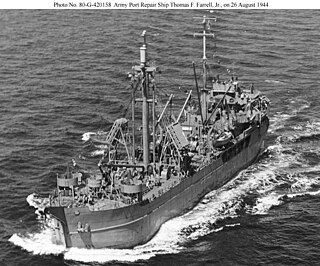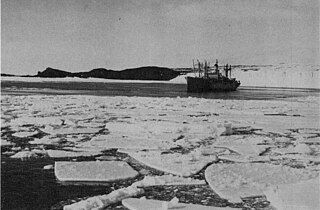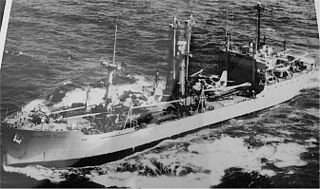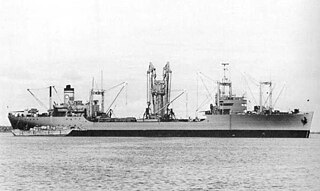
USNS Kingsport (T-AG-164) was built as SS Kingsport Victory, a United States Maritime Commission VC2-S-AP3 (Victory) type cargo ship. During the closing days of World War II the ship was operated by the American Hawaiian Steamship Company under an agreement with the War Shipping Administration. After a period of layup the ship was operated as USAT Kingsport Victory by the Army under bareboat charter effective 8 July 1948. When Army transports were transferred to the Navy's Military Sea Transportation Service the ship continued as USNS Kingsport Victory (T-AK-239), a cargo transport. On 14 November 1961, after conversion into the first satellite communication ship, the ship was renamed Kingsport, reclassified as a general auxiliary, and operated as USNS Kingsport (T-AG-164).

Sagitta (AK-87) was never commissioned and thus never bore the USS designation.
USNS Lt. James E. Robinson (T-AKV-3/T-AG-170/T-AK-274) was a Lt. James E. Robinson-class cargo ship, which was launched as a World War II commercial Victory cargo ship SS Czechoslovakia Victory under the Emergency Shipbuilding program. She had earlier been the U.S. Army's USAT LT. James E. Robinson before being acquired by the U.S. Navy.
USNS Sgt. Joseph E. Muller was a C1-M-AV1 cargo ship completed 9 June 1945 and delivered to the War Shipping Administration (WSA) as Check Knot. After operation by WSA's agent Waterman Steamship Company June 1945 – November 1946 and being placed in reserve the ship was transferred to the U.S. Army and renamed USAT Sgt. Joseph E. Muller. She was transferred to the United States Navy in 1950 after the establishment of the Military Sea Transportation Service under Navy and assigned to Korean War supply and transport operations. She was again place back in service in 1962 as one of the civilian crewed, Auxiliary General (AG), technical research ships working on National Security Agency/Naval Security Group missions, based out of Florida. She was finally declared surplus to needs in 1969 and struck.

USNS Sgt. Curtis F. Shoup (T-AG-175) was a C1-M-AV1 coastal freighter. Built as Spindle Eye, one of the many named for knots. The ship, modified to be a "news transmission ship" for the press during the planned invasion of Japan, was completed 9 July 1945, delivered to the War Shipping Administration and placed under its agent Lykes Brothers Steamship Company the same day. Days later, on 26 July, Spindle Eye was bareboat chartered to the War Department for operation by the Army. The ship was renamed November 1947 by the Army, after serving as a radio relay ship at the Operation Crossroads atomic bomb tests and conversion to an Army passenger-cargo vessel, Sgt. Curtis F. Shoup in honor Sergeant Curtis F. Shoup who had been awarded the Medal of Honor.

USS Pembina (AK-200) – later known as USNS Pembina (T-AK-200) -- was an Alamosa-class cargo ship that was constructed for the U.S. Navy during the closing period of World War II. She supported the end-of-war Navy effort and was subsequently placed in service with the US Army under the Shipping Control Authority for the Japanese Merchant Marine with a Japanese crew in Yokosuka, Japan.
USNS Sgt. George Peterson (T-AK-248) was a US Maritime Administration (MARCOM) C1-M-AV1 type coastal cargo ship, originally planned as an Alamosa-class cargo ship. The contract for building was canceled by the Navy in August 1945. The ship, however, was completed as SS Coastal Guide. She was later acquired by the US Army, in 1948, and renamed USAT Sgt. George Peterson. She was reacquired by the Navy, in 1950, and placed in service by the Military Sea Transportation Service (MSTS) as USNS Sgt. George Peterson (T-AK-248). She remained with the Navy until struck in 1966. She was sold in 1971.

USNS Private John R. Towle (T-AK-240) was a Greenville Victory-class cargo ship that served as a commercial cargo ship during the final year of World War II. Post-war she was acquired by the U.S. Army as USAT Private John R. Towle until the 1950s when she was assigned to the U.S. Navy's Military Sea Transportation Service for various duties, including runs to Antarctica's McMurdo Sound.

USNS Private Francis X. McGraw (T-AK-241) was a Boulder Victory-class cargo ship built at the end of World War II and served the war and its demilitarization as a commercial cargo vessel. From 1946 to 1950 she served the U.S. Army as a transport named USAT Private Francis X. McGraw. In 1950 she was acquired by the United States Navy and assigned to the Military Sea Transportation Service. In 1974 she ended her career and was scrapped.

USNS Sgt. Archer T. Gammon (T-AK-243) was a Boulder Victory-class cargo ship built at the end of World War II and served the war and its demilitarization as a commercial cargo vessel. From 1946 to 1950 she served the U.S. Army as a transport named USAT Sgt. Archer T. Gammon. In 1950 she was acquired by the United States Navy and assigned to the Military Sea Transportation Service. In 1973 she ended her career and was struck and scrapped.
USNS Sgt. Morris E. Crain (T-AK-244) was a Boulder Victory-class cargo ship built at the end of World War II and served in the war prior to its demilitarization as a commercial cargo vessel. From post-war to 1950 she served the U.S. Army as a transport named USAT Morris E. Crain. In 1950 she was acquired by the U.S. Navy and assigned to the Military Sea Transportation Service. In 1975 she ended her career and was placed into reserve.

USNS Colonel William J. O’Brien (T-AK-246) was a US Maritime Administration (MARCOM) C1-M-AV1 type coastal cargo ship, originally planned as an Alamosa-class cargo ship. Constructed as Maiden's Eye for the MARCOM, completed in August 1945 and placed in operation by the War Shipping Administration (WSA). After the war Maiden's Eye was transferred to the US Army and renamed USAT Colonel William J. O’Brien who kept her in service until transferred to the US Navy in 1950 for operation as USNS Colonel William J. O’Brien (T-AK-246) by the Military Sea Transportation Service (MSTS) until 1973.
USNS Private John F. Thorson (T-AK-247) was a US Maritime Administration (MARCOM) C1-M-AV1 type coastal cargo ship, originally planned as an Alamosa-class cargo ship. Constructed as Becket Bend for MARCOM, completed in August 1945 and placed in operation by the War Shipping Administration. However, the war ended, and she was transferred to the US Army as USAT Private John F. Thorson who kept her in service until transferred to the US Navy in 1950. She was struck in 1960, ending her military career.
USNS Short Splice (T-AK-249) was a US Maritime Administration (MARCOM) C1-M-AV1type coastal cargo ship, originally planned as an Alamosa-class cargo ship. Constructed as Short Splice for MARCOM, completed in August 1945 and placed in operation by the War Shipping Administration during the closing period of World War II. However, the war ended, and she was transferred to the US Army as USAT Short Splice who kept her in service until transferred to the US Navy in 1950.

USNS Private Frank J. Petrarca (T-AK-250) was a US Maritime Administration (MARCOM) C1-M-AV1 type coastal cargo ship, originally planned as an Alamosa-class cargo ship. Constructed as Long Splice for MARCOM, completed in September 1945 and placed in operation by the War Shipping Administration (WSA) during the closing period of World War II. However, the war ended, and she was transferred to the US Army as USAT Private Frank J. Petrarca who kept her in service until transferred to the US Navy in 1950.
USNS Sgt. Truman Kimbro (T-AK-254) was a Boulder Victory-class cargo ship built for the U.S. Maritime Commission during the final months of World War II as the SS Hastings Victory.
USNS Flyer (T-AG-178), was a type C2-S-B1 cargo ship of the United States Navy, built for the Maritime Commission (MC) as Water Witch in service under charter by the Commission to several lines until purchased in 1946 by United States Lines and renamed American Flyer. After being placed in the Reserve Fleet 14 December 1964 the title was transferred to the Navy for use as a deep ocean bathymetric survey ship supporting installation of the Sound Surveillance System (SOSUS). The Navy placed the ship in service 9 February 1965 with the name Flyer given on 22 March. The ship operated in that role until 1975.

USNS Private Leonard C. Brostrom (T-AK–255) was a cargo ship for the United States Navy that was converted into a heavy lift cargo ship in the early 1950s. She was built in 1943 for the United States Maritime Commission as SS Marine Eagle, a Type C4-S-B1 tank carrier, by Sun Shipbuilding during World War II. In 1948, she was transferred to the United States Army as USAT Private Leonard C. Brostrom after Leonard C. Brostrom, a recipient of the Medal of Honor. In 1950, the ship was transferred to the Military Sea Transport Service of the U.S. Navy as a United States Naval Ship staffed by a civilian crew. After ending her naval service, she entered the National Defense Reserve Fleet in October 1980 and was sold for scrapping in June 1982.

USNS Pvt. Joseph F. Merrell (T-AK-275),, was a Victory ship and the second ship of the Lt. James E. Robinson-class cargo ship built in 1944. The ship is named after Private Joseph F. Merrell, an American soldier who was awarded the Medal of Honor during World War II.










